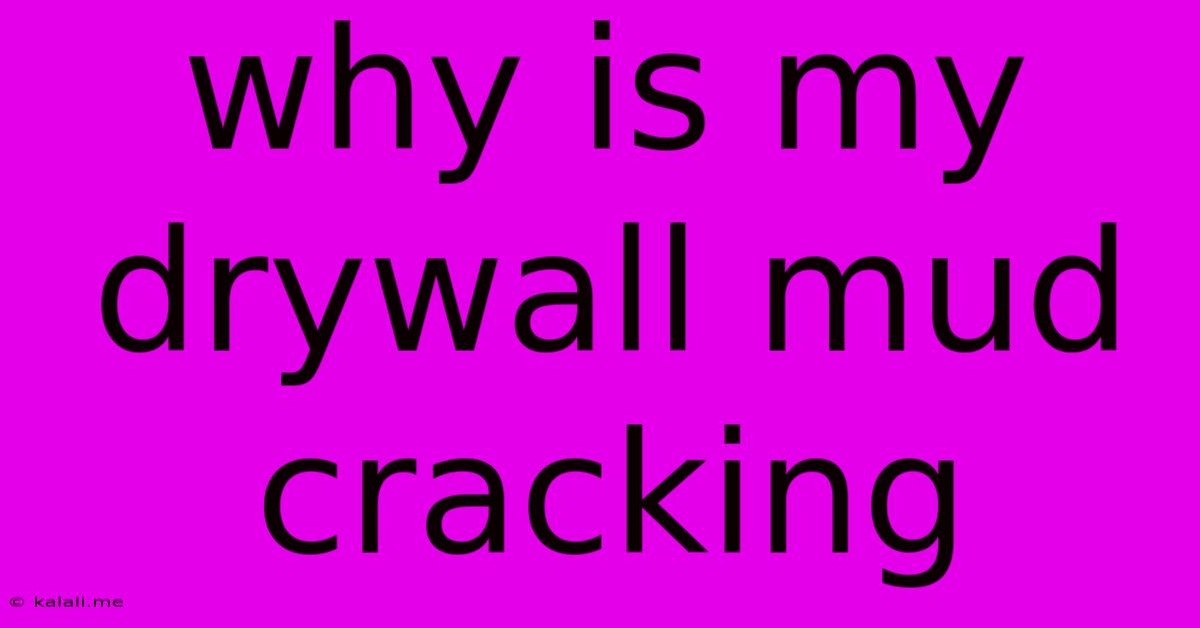Why Is My Drywall Mud Cracking
Kalali
Jun 06, 2025 · 3 min read

Table of Contents
Why is My Drywall Mud Cracking? A Comprehensive Guide to Troubleshooting
Drywall mud cracking is a frustrating problem for DIYers and professionals alike. A smooth, flawless finish is the goal, and cracks disrupt that aesthetic perfection. But understanding why your drywall mud is cracking is the first step to fixing it and preventing future issues. This article dives deep into the common causes, offering practical solutions to help you achieve that professional-looking finish.
Cracked drywall mud significantly impacts the overall look of your room, detracting from a smooth, painted surface. This guide provides the necessary information to troubleshoot and resolve the issue, leading to a higher quality finish.
Common Causes of Drywall Mud Cracking
Several factors contribute to drywall mud cracking. Let's break them down into manageable categories:
1. Improper Mud Application:
- Too thick coats: Applying excessively thick layers of drywall mud is a major culprit. The mud needs time to dry completely, and thick layers dry slower, leading to stress and cracking as they shrink. Always apply thin coats and allow ample drying time between each.
- Insufficient drying time: Rushing the process is a recipe for disaster. Each coat needs to dry thoroughly before applying the next. Ignoring this crucial step creates weak points prone to cracking. Patience is key! Consider using fans to circulate air and expedite drying, but avoid placing them directly onto the drying mud.
- Poor feathering: Feathering refers to gradually blending the edges of the mud into the surrounding drywall. If the edges aren't properly feathered, they'll create a stress point, making cracking more likely. Proper feathering is essential for a smooth and durable finish.
- Incorrect mixing: Using too much water or not mixing the mud thoroughly can result in a weaker compound more susceptible to cracking. Always follow the manufacturer's instructions for mixing ratios and techniques.
2. Substrate Issues:
- Movement in the wall: Cracks can appear due to movement within the wall itself. This could be caused by settling of the house, thermal expansion and contraction, or even vibrations. Inspect the wall carefully for any other signs of movement. Addressing underlying structural issues is often necessary before tackling the mud.
- Poorly taped joints: If the drywall tape wasn't properly embedded in the mud during the initial taping process, it can create weak points that lead to cracking. Ensure complete adhesion of the tape to the drywall.
- Unprimed drywall: Applying mud directly onto unprimed drywall can lead to adhesion problems and cracking. Always prime the drywall before applying mud, especially with highly absorbent surfaces.
3. Environmental Factors:
- Extreme temperature fluctuations: Rapid changes in temperature and humidity can cause the drywall mud to expand and contract, leading to stress and cracking. Maintaining a stable temperature and humidity level during the drying process is crucial.
- Low humidity: Dry air can cause the mud to dry too quickly, resulting in shrinkage and cracking. Consider using a humidifier in very dry environments.
4. Type of Mud Used:
- Incorrect mud type: Using the wrong type of mud for the application (e.g., all-purpose mud for taping instead of joint compound) can result in a less durable finish prone to cracking. Choose the appropriate mud for each stage of the process.
Preventing Drywall Mud Cracking: Tips and Best Practices
- Use high-quality materials: Invest in good quality drywall mud and tape.
- Proper preparation: Ensure the drywall is clean, dry, and primed before application.
- Thin coats: Apply multiple thin coats instead of a few thick ones.
- Adequate drying time: Allow sufficient drying time between coats.
- Proper feathering: Blend the edges of the mud seamlessly into the surrounding drywall.
- Use a primer: Applying a primer before painting helps prevent cracking and provides better paint adhesion.
- Address underlying structural issues: If cracks persist, it might indicate a more serious structural problem requiring professional attention.
By understanding the causes and implementing these preventive measures, you can significantly reduce the chances of your drywall mud cracking, leading to a smoother, more professional-looking finish that will last. Remember, patience and attention to detail are key to success!
Latest Posts
Latest Posts
-
The Execute Permission Was Denied On The Object
Jun 06, 2025
-
How Do You Get The Holy Spirit
Jun 06, 2025
-
Awk Print A Range Of Columns
Jun 06, 2025
-
Do We Say Happy Pride To People
Jun 06, 2025
-
What Cna Analog Signals Do That Digital Signals Dont
Jun 06, 2025
Related Post
Thank you for visiting our website which covers about Why Is My Drywall Mud Cracking . We hope the information provided has been useful to you. Feel free to contact us if you have any questions or need further assistance. See you next time and don't miss to bookmark.